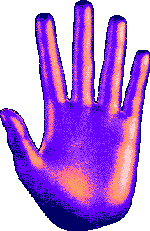












“Loop of Hope” is an appropriation of the architectural sculpture Gate of Hope by Dan Graham. Through the method of photogrammetry, the sculpture was transferred into a 3-dimensional rendering and was relocated from its original physical space, (Leibfriedschen Garten, Stuttgart) to a virtual space without visible boundaries or physical properties.
The digital representation of the Gate of Hope and another amorphous object, are facing each other, hovering in circles in the virtual space. The representation of the Gate of Hope, resultant from a particular software, is a flat surface. Differing greatly from its original, a specific form of pyramid called a tetrahedron.
Through the motion of these two objects, a shift of perception is caused. The spectator, who is used to walking around a sculpture, is orbited by it. This unmovable massive sculpture, with the scale of a small house, made of concrete, steel and one way mirror, is set in motion. The pendant, an undefinable object, appears as a fragment of the surroundings due to the unknown parameters of the software.
These surroundings; trees, bushes and a path, define the place of perception and contextualisation of the artwork. A park is a public space, but what does ‚public space’ suggest? In terms of accessibility, can the internet be the new public space? What happens to an artwork when you move it from one place to another? In the case of Loop of Hope – Gate of Hope, does its online presence damage the impact of its physical counterpart?
The great goal of virtual reality is immersion; creating a perfect illusion of reality. In other words, the consignee isn´t able to differ reality from virtuality. The aim is to substitute the real with the virtual. Will an illusion overcome the uncanny valley?
The spatial semantics of the physical are applied to that of the virtual and internet space. Physical navigation is implied through the language: ‘go’ online, a ‘portal’, a ‘chatroom’, a ‘firewall’, to ‘surf’ and so on.
By questioning the title Gate of Hope, one begins an exploration into the purpose and functionality of a physical gate/gateway. An opening, defining the entrance into new space, providing access to a place of shelter, yet the sculpture does not fulfil these parameters. It’s a construction within an open park space: by walking through it, one does not physically change spaces, but moves through the structure.
Continuing, what role does ‚hope’ play in this inanimate object. How can it represent an optimistic state of mind regarding expectations of the future? The word ‚hope’ implies irrationality, contradicting the geometric form of the static sculpture. Linguistically, one questions where hope comes from or where it goes.
The act of appropriating another artist’s work shifts into a realm of implications, regarding authorship, originality and uniqueness. Amending the title of the original, Loop of Hope eludes to the basic action of the VR-video loop. The two objects are set in an endless dialogue through hovering circles. Never getting closer and unable to touch. The mutual dependence of the artwork and its environment is crucial, like its dependence on the spectator. The loop, a virtual rendition of the circle, has numerous symbolic meanings and associations. Found in science, philosophy, religion, cults, art and society; the loop pertains to themes of perfection and transcendence, repetition and return, similarity and correspondence, certainty and safety.
Is there validity to both the copy and the original?